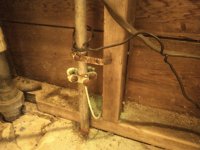Greetings group,
Given now that the new 680.14(B) requires equipment in a pool equipment room to be suitable for corrosive environments,
what about bonding the pump motor to the pool?
680.26(B)(6)(2) requires me to bond the pump (in a equipment shed that is a corrosive environment) to the pool, and this is an existing pool.
The new pump in question is all non-metallic and is tied into existing PVC piping and it does have a nice big copper grounding lug on it.
If I run a #8 from that lug and hit the metallic pool pipes with a ground clamp, how do I make that suitable for a "corrosive environment"?
The once brass pipes are all green and it's in a pool equipment room.
I think by the time I get back there that new copper lug will be green.
Is there some kind of epoxy or spray for the copper?
Thanks in advance.
Given now that the new 680.14(B) requires equipment in a pool equipment room to be suitable for corrosive environments,
what about bonding the pump motor to the pool?
680.26(B)(6)(2) requires me to bond the pump (in a equipment shed that is a corrosive environment) to the pool, and this is an existing pool.
The new pump in question is all non-metallic and is tied into existing PVC piping and it does have a nice big copper grounding lug on it.
If I run a #8 from that lug and hit the metallic pool pipes with a ground clamp, how do I make that suitable for a "corrosive environment"?
The once brass pipes are all green and it's in a pool equipment room.
I think by the time I get back there that new copper lug will be green.
Is there some kind of epoxy or spray for the copper?
Thanks in advance.

